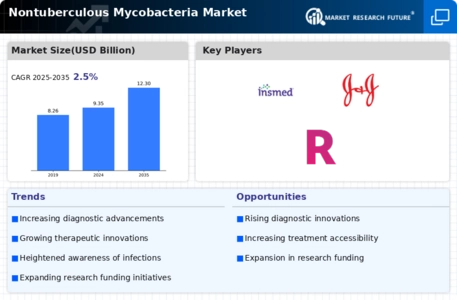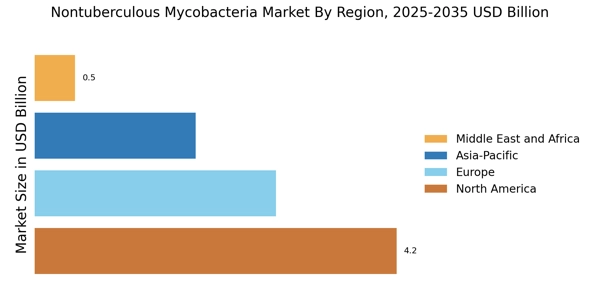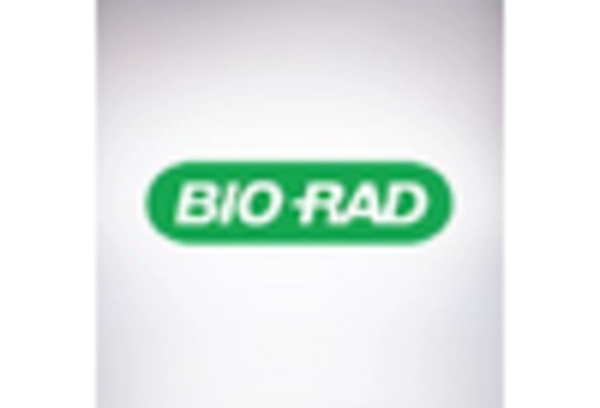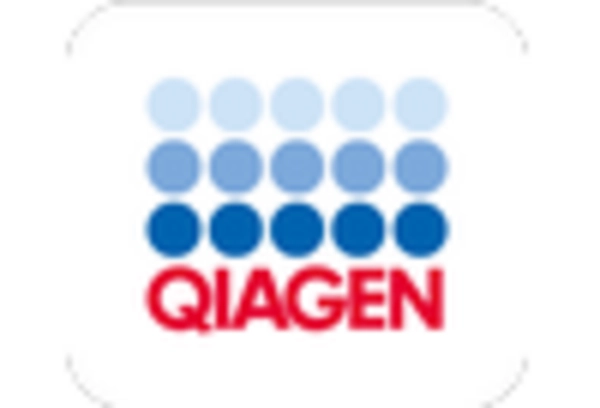Advancements in Diagnostic Technologies
Technological advancements in diagnostic methodologies are significantly influencing the Nontuberculous Mycobacteria Market. The development of rapid and accurate diagnostic tools, such as molecular assays and next-generation sequencing, has improved the detection rates of nontuberculous mycobacteria. These innovations facilitate timely diagnosis, which is crucial for effective treatment and management of infections. As healthcare systems increasingly adopt these advanced technologies, the Nontuberculous Mycobacteria Market is poised for growth. Market data suggests that the demand for molecular diagnostics is expected to rise, driven by the need for precise identification of mycobacterial species. This trend underscores the importance of investing in research and development to enhance diagnostic capabilities in the field.
Growing Investment in Research and Development
The growing investment in research and development is a key driver for the Nontuberculous Mycobacteria Market. Pharmaceutical companies and research institutions are increasingly focusing on understanding the pathogenesis of nontuberculous mycobacteria and developing novel therapeutic agents. This influx of funding is likely to accelerate the discovery of new drugs and treatment protocols, addressing the unmet medical needs associated with these infections. Furthermore, collaborative efforts between academia and industry are fostering innovation, which may lead to breakthroughs in the management of nontuberculous mycobacterial diseases. As a result, the Nontuberculous Mycobacteria Market is expected to benefit from a robust pipeline of new products and therapies in the coming years.
Rising Awareness Among Healthcare Professionals
Rising awareness among healthcare professionals regarding nontuberculous mycobacterial infections is driving the Nontuberculous Mycobacteria Market. Educational initiatives and training programs are enhancing the understanding of these infections, leading to improved diagnosis and treatment practices. As healthcare providers become more knowledgeable about the clinical implications of nontuberculous mycobacteria, there is a corresponding increase in the number of patients being tested and treated. This heightened awareness is likely to result in a greater demand for diagnostic tools and therapeutic options, thereby stimulating market growth. The Nontuberculous Mycobacteria Market stands to gain from this trend, as healthcare systems adapt to the evolving landscape of infectious diseases.
Emerging Markets and Increased Healthcare Access
Emerging markets are playing a crucial role in the expansion of the Nontuberculous Mycobacteria Market. As healthcare access improves in developing regions, there is a growing recognition of the need to address infectious diseases, including those caused by nontuberculous mycobacteria. Increased healthcare infrastructure and investment in public health initiatives are likely to enhance diagnostic and treatment capabilities. This trend may lead to a rise in the diagnosis of nontuberculous mycobacterial infections, further driving market demand. Additionally, the Nontuberculous Mycobacteria Market could benefit from partnerships with local healthcare providers to facilitate the distribution of diagnostic and therapeutic solutions in these emerging markets.
Increasing Incidence of Nontuberculous Mycobacterial Infections
The rising incidence of nontuberculous mycobacterial infections is a pivotal driver for the Nontuberculous Mycobacteria Market. Reports indicate that the prevalence of these infections has been steadily increasing, particularly among immunocompromised individuals and those with underlying lung diseases. This trend necessitates enhanced diagnostic and therapeutic solutions, thereby propelling market growth. The Nontuberculous Mycobacteria Market is expected to witness a surge in demand for innovative treatment options, as healthcare providers seek to address the growing burden of these infections. Furthermore, the increasing recognition of the clinical significance of nontuberculous mycobacteria among healthcare professionals is likely to contribute to the expansion of the market, as more patients are diagnosed and treated.


















Leave a Comment